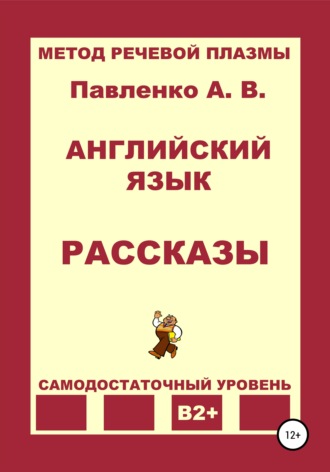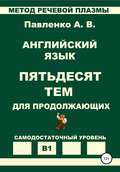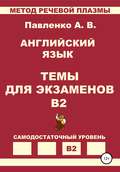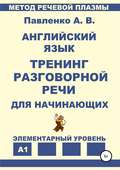
Александр Владимирович Павленко
Английский язык. Рассказы. Уровень В2+
A Trip to Crete
Last year my wife and I spent our holidays in Crete, the southernmost island in Greece, and we made lots of little excursions there into the countryside. On one occasion, we wanted to visit the south side of the island, where there are some ruins from the Roman times and from a former monastery. We went there by bus, travelling along tiny little windy roads. It was quite frightening to watch how the bus driver was manoeuvring the vehicle around all of the twisty curves in the road, quite breathtaking. At every curve we were scared that the bus would crash, and the bus driver had to signal with his horn at each turning as it was impossible to see if any traffic was coming from the other direction and there wasn’t enough space on the road for two vehicles to pass side by side.
When we arrived at the nearest bus stop to the ruins, we could see them in the distance, and we could see that there were only two ways to get there – on foot, or by boat, if we had one, which we didn’t. So, we started walking in that direction, along a dried up river bed. From the map it seemed that the distance we had to walk was about three kilometres, but it must have been longer, as it took us about three hours of difficult climbing and scrambling over rocks to get there.
At one point on the way we reached the top of a hill, from which we had an amazing view of the ruins. There we met a boy from France, who we shared friendly gestures with, but couldn’t really speak with as we didn’t speak a foreign language. We climbed down from there together, into the grounds of the ruins. There was a fence blocking our path, but it was quite small and easy to climb over.
In the grounds of the ruins were some very twisty, gnarled old olive trees, and at the entrance we found a beautiful mosaic from the Roman times, leading to many little paths. The monastery was very small. Each of the monks’ cells were just tiny little box-like rooms, two by three metres in size. The whole place had a beautiful, ancient atmosphere.
By the time we got there we were very tired after so much walking and weren’t looking forward to the long trek back to the bus stop. We weren’t even sure that we would get there in time for the last bus. Fortunately, we met a fisherman on the beach, who was there fishing for octopuses. He was kind enough to take us back to the road by boat, which only took about ten or fifteen minutes, and the walk to the bus stop from where he dropped us off was very short. We were well in time to catch the bus. We were very happy, if a little exhausted, after a nice, interesting trip.
A Trip to Crete
1. Where did they spend their holidays last year?
2. What did they do while on holiday?
3. Why did they want to visit the south part of the island?
4. How did they get there?
5. Why did they find their trip frightening?
6. What were they afraid of?
7. Why did the driver have to signal with his horn at turnings?
8. How could they get to the ruins from the bus stop?
9. How long did it take them to get there?
10. Where did they meet a boy from France?
11. What was the trouble communicating with him?
12. What did they have to get over when they got to the ruins?
13. What did they find at the entrance of the ruins?
14. What size were the monks’ cells?
15. What did they think of the place?
16. Why weren’t they eager to walk back to the bus stop?
17. What could happen if they had walked to the bus stop?
18. Who did they meet?
19. What was the fisherman doing there?
20. What was the favour he did them?
21. How long did the boat trip take?
22. Did the fisherman drop them off at the bus stop?
23. How did they reach the bus stop then?
24. Did they catch the last bus?
25. How did they feel at the end of the day?
A Trip to Crete
Training 1
They went there by bus, travelling along tiny little windy roads. It was quite frightening to watch how the bus driver was manoeuvring the vehicle around all of the twisty curves in the road, quite breathtaking. At every curve they were scared that the bus would crash, and the bus driver had to signal with his horn at each turning as it was impossible to see if any traffic was coming from the other direction.
Training 2
There were only two ways to get to the ruins – on foot, or by boat. So, they started walking in that direction, along a dried-up riverbed. From the map it seemed that the distance they had to walk was about three kilometres, but it must have been longer, as it took them about three hours of difficult climbing and scrambling over rocks to get there.
Training 3
At one point on the way they reached the top of a hill, from which they had an amazing view of the ruins. There they met a boy from France, who they shared friendly gestures with, but couldn’t really speak with as they didn’t speak a foreign language. They climbed down from there together, into the grounds of the ruins. There was a fence blocking their path, but it was quite small and easy to climb over.
Training 4
In the grounds of the ruins were some very twisty, gnarled old olive trees, and at the entrance they found a beautiful mosaic from the Roman times, leading to many little paths. The monastery was very small. Each of the monks’ cells were just tiny little box-like rooms, two by three metres in size. The whole place had a beautiful, ancient atmosphere.
Training 5
Fortunately, they met a fisherman on the beach, who was there fishing for octopuses. He was kind enough to take them back to the road by boat, which only took about ten or fifteen minutes, and the walk to the bus stop from where he dropped them off was very short. They were well in time to catch the bus. They were very happy, if a little exhausted, after a nice, interesting trip.
Pub Music in Edinburgh
I first became involved in playing Irish music many years ago when I first visited Ireland and was greatly inspired after attending some great folk festivals there. The first one I went to was in County Sligo, in Ballisadare. There were so many great groups playing there – DeDanaan, The Bothy Band, Clannad, all the best-known Irish musicians of that time. There were thousands of tents and thousands of people everywhere, and there was a really great atmosphere. The whole thing lasted for three days, and I had a really nice time.
What struck me most was the power of the sound of the fiddle, such a fantastic instrument. I took up the fiddle when I was a small child but dropped it when I came to the age of about thirteen. But after seeing those folk play in Ireland, well, I had to pick it up again. I brought some sheet music back from Ireland, and when I got back home to Dorchester, joined a local folk music club and tried a few tunes. First, we played the tunes very slowly. You wouldn’t recognize them because they were so slow, but gradually I learnt a few of them by heart.
Then I moved to Edinburgh, because my wife, Sophie, is a scientist, and she got a grant to go and work at the University of Edinburgh. She was looking for a place to work where she could work well and expand her knowledge, and at the same time somewhere where I would feel happy. We considered Ireland and Scotland, and eventually decided upon Scotland. I found some work there too. I am also a scientist, a biologist, specializing in mosses. There are so many mosses in Scotland, and I knew people up there who were also involved in studying mosses, so I found myself working for the peat land section of the Scottish Heritage Trust. At home I’d just finished a big study on heavy metal deposition, which can be gauged by analyzing mosses, and I had some good opportunities to talk with other experts about my results, as well as to collect mosses.
My time in Edinburgh was one of the finest times of my life, because I enjoyed my work, and there was great music in the evenings. I went out three times a week to folk music sessions, which took place in a few of the local pubs, and met some really great musicians there, some lovely people. We’d go in and sit down in the pub at the beginning of the evening, have a drink, and would be chatting away when someone would get out their instrument and start playing. Then others that knew the tune they were playing would join in. Some people would play regularly in each pub, and there were always people passing through. The first session I went to I discovered by luck. I just went into the pub and saw that there were people playing, and once you’re in one session it’s easy to find out from the musicians the times and places of others. I really was a bad fiddle player at the time, but I tried to play a bit and listened a lot, and people were very kind to me and took me to lots of sessions. I’m not a great player at the moment, but I think I’ve improved a bit since then! I took a portable tape recorder with me and recorded, session by session, many tunes, and tried to learn some of them when I had some spare time. I learned a lot from listening and watching how others played – and there were some really talented players in Edinburgh at that time, like John Martin, for example. You can’t imagine how good some of the playing was. There were also people playing the mandolin and the flute, Irish pipes and guitars.
A lot of people from Northern Ireland, particularly from Donegal, used to come to the Edinburgh sessions, and they were a strong influence. There are some pubs where people play Irish music there, and some where people play Scottish music. There were always more people playing in the Irish sessions, maybe because Scottish music is usually played by a solo instrument, maybe with a guitar accompaniment, whereas in Irish music you often find five or six fiddles playing together, which is, I think, more exciting. Also, in the Scottish sessions, you’d very rarely hear any songs, which were more common in the Irish ones.
I wouldn’t have liked to live in Edinburgh forever, but I had a really fantastic time there and I was sad to leave. The time there was too short, even for our kids. The kids went to school there, and for our son it was the first time he’d been to school. They both picked up a strong Scottish accent!
Pub Music in Edinburgh
1. When did Greg first become involved in playing Irish music?
2. What was the first festival he visited like?
3. What struck him most at the festival?
4. When did he take up fiddle?
5. Why did he have to learn playing it again?
6. How did he pick up the fiddle back home?
7. Why did they move to Edinburgh?
8. What did Greg and his wife do?
9. What about Greg’s work in Scotland?
10. Why did he enjoy living in Edinburgh?
11. How often did he go to folk music sessions?
12. Where did they take place?
13. What did they do at the sessions?
14. How did he happen to discover those sessions?
15. How did he turn into a regular session player?
16. What kind of fiddle player was Greg at the time?
17. Has he improved since then?
18. What did he do to improve?
19. What other instruments did some of the musicians play?
20. Did they only play Scottish music in the pubs in Edinburgh?
21. How did it happen that there were Irish sessions in Edinburgh?
22. Why were there more people playing in the Irish sessions?
23. Were songs typical for Scottish sessions?
24. How did he feel when he had to leave Edinburgh?
25. Why was that time prominent for their children, too?
Pub Music in Edinburgh
Training 1
Greg first became involved in playing Irish music many years ago when he first visited Ireland. He was greatly inspired after attending some great folk festivals there. The first one he went to was in County Sligo. There were so many great groups playing there. There were thousands of tents and people everywhere, and there was a really great atmosphere.
Training 2
Greg took up the fiddle when he was a small child but dropped it when he came to the age of about thirteen. But after seeing those folk play in Ireland, Greg had to pick it up again. He brought some sheet music back from Ireland, and when he got back home, joined a local folk music club and tried a few tunes. First, they played the tunes very slowly. But gradually Greg learnt a few of them by heart.
Training 3
He moved to Edinburgh, because his wife got a grant to work at the University of Edinburgh. She was looking for a place to work where she could expand her knowledge, and at the same time somewhere where Greg would feel happy. They eventually decided upon Scotland. Greg found some work there too. He is a biologist, specialising in mosses. And he had some good opportunities to talk with other experts, as well as to collect mosses.
Training 4
While they were living in Edinburgh Greg went out three times a week to folk music sessions. They’d go in, sit down in the pub, and have a drink, and someone would get out their instrument and start playing. Then others would join in. Greg really was a bad fiddle player at the time, but he learned a lot from listening and watching how others played.
Training 5
A lot of people from Northern Ireland used to come to the Edinburgh sessions, and they were a strong influence. There are some pubs where people play Irish music, and some where people play Scottish music. There were always more people playing in the Irish sessions, maybe because in Irish music you often find five or six fiddles playing together or because songs were more common in the Irish sessions.
Balalaikas in Syria
My friend Alexander, who is Russian, told me an interesting story about a trip he made to Damascus, in Syria, a few years ago. He was working in a city in the heart of Siberia as an interpreter for a dancing group, composed of boys and girls aged between about fourteen and seventeen. They were a very professional dancing group, as they’d all started dancing at about the age of six, and had been training intensively since then, every day, learning many different types of dances, so it was very impressive to see them. It was a real pleasure for my friend to work with them, and to see them dance so often. Every time he looked at them, he couldn’t help admiring them, as they danced so magnificently, better than many adult dancing groups that he’d seen.
Anyway, they travelled to Damascus in July or August, in the middle of summer, so it was rather hot in Siberia at that time, about twenty-nine degrees Celsius, so everybody was sweating. He said to them before they left, “Don’t forget where we are going, we’re going to Damascus, very close to the desert, and it’s going to be something like forty-seven or even fifty degrees.”
When they arrived at the airport, however, and got out of the plane, they didn’t believe that they were in a desert region, as they all felt a little bit chilly! When it was announced at the airport that it was just eighteen degrees, they couldn’t believe their ears.
The next day, however, the heat wave came, and it was blistering hot. The temperature reached forty-seven degrees, and so during the day it was almost impossible for my friend and his group to go out into the street without staying in the shade. They could walk along covered walkways, or stay under the canvas awnings of cafes, but it was absolutely unbearable to be in the open.
My friend said that during the daytime in the summer there it is just like a dead city, with nearly empty streets with only very few people walking here and there and no other signs of life. But when the sun goes down, at about nine o’clock in the evening, life there really begins. All of the people come out into the streets, the cafes and restaurants open, and the social life starts. They go to parties, visit each other, buy, and sell things, go to the cinemas – everything starts at nine in the evening and carries on until about two or three in the morning. For my friend it was like an upside-down world, as in Siberia everything closes at about nine, life finishes and everybody goes to bed.
Another thing that surprised Alex was that whereas in Russia it’s very unusual for children to go out with their parents to restaurants and to places in the evening, in Damascus it’s normal. The children may be three or four years old; you will be sitting and drinking and talking, and the children either sit down next to their parents or, more usually, run around between the tables and play. This was so unusual for my friend to experience, especially as Russia had been so restricted because of the Iron Curtain and he’d never had the opportunity to travel abroad before.
Their dancing tour was a great success. They were in several cities – Damascus, Aleppo and two or three more, and in each place that they danced the audiences went wild. They applauded and called for encores again and again and again. They were accompanied by a small group of musicians playing Russian instruments, balalaikas, and this was very unusual for the local people who were mostly Arabs, as their music was absolutely different, so they were altogether amused, amazed and thoroughly entertained.
They were especially successful in Aleppo, as thirty thousand Armenians live there. Armenia was a republic of the Soviet Union, and when they learnt that a group from Russia were playing, and also that they played music by Khachaturian, the famous Armenian composer, they flocked to the performance. They were fantastically well-received. The audience applauded and encored them many times and were very enthusiastic, maybe because they liked this music so much and felt a deep connection with it.
They stayed in a beautiful five-star hotel, with luxurious facilities, swimming pools, huge four-course meals, top-class service, and things like this, and that was such a surprise for my friend, who had never been out of Russia before in his life. It was an absolutely fantastic experience for him, one of the greatest experiences of his life.
Balalaikas in Syria
1. Where did Alexander travel?
2. What was he doing then?
3. How did those teenagers become professionals so early?
4. When did they travel to Damascus?
5. What was the weather like in Siberia when they left?
6. What did Alexander warn his group about?
7. What surprised them when they arrived at the airport?
8. What was the temperature like the next day?
9. How could they get around in the city during the day?
10. What was Damascus like during the daytime?
11. When does life really begin?
12. What do the locals do in the evening?
13. Is such a vivid night life typical for Siberia?
14. What was another thing that surprised Alexander?
15. Had he travelled a lot before this trip?
16. How did the audience meet the group?
17. What was unusual for the local public in terms of music?
18. Where were they especially successful?
19. What could be the reason for that?
20. Whose music did they play among others?
21. How did the audience receive them in Aleppo?
22. Where did they stay?
23. What facilities were there at those hotels?
24. Why was it such a great surprise for Alexander?
25. What did he think of that trip?
Balalaikas in Syria
Training 1
My Russian friend Alexander made a trip to Syria some years ago. He was working in a city in the heart of Siberia as an interpreter for a dancing group, composed of boys and girls. They were a very professional dancing group, as they’d all started dancing at about the age of six and had been training intensively since then. Every time he looked at them, he couldn’t help admiring them, as they danced better than many adult dancing groups that he’d seen.
Training 2
They travelled to Damascus in the middle of summer. When they arrived at the airport, however, it was announced that it was just eighteen degrees, so they couldn’t believe their ears. The next day, however, the heat wave came, and it was blistering hot. The temperature reached forty-seven degrees, and so during the day it was absolutely unbearable to be in the open.
Training 3
During the daytime in the summer Damascus is just like a dead city, with nearly empty streets with only very few people and no other signs of life. But when the sun goes down life there really begins. All of the people come out into the streets, the restaurants open, they go to parties, visit each other, buy and sell things, go to the cinemas – everything starts at nine in the evening and carries on until about two or three in the morning.
Training 4
Their dancing tour was a great success. They were in several cities, and in each place that they danced the audiences went wild. They applauded and called for encores again and again. They were accompanied by a small group of musicians playing Russian instruments, balalaikas, and this was very unusual for the local people, as their music was absolutely different, so they were altogether amused, amazed and thoroughly entertained.
Training 5
They stayed in a beautiful five-star hotel, with luxurious facilities, swimming pools, huge four-course meals, top-class service and things like this, it was an absolutely fantastic experience. This was so unusual for my friend, especially as Russia had been so restricted because of the Iron Curtain and he’d never had the opportunity to travel abroad before.







